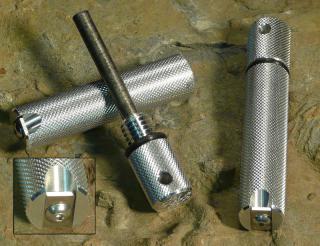Monday, January 07 2013
Following the discovery of gold in Coloma, California on January 24, 1848, boomtowns sprang up quicker than weeds. Just eight miles away, Old Dry Diggins was one such tent-filled mining camp that took root. So named because miners had to move cartloads of dry soil to running water in order to separate out the gold, the population quickly swelled from hundreds of gold seekers to thousands. As to be expected, things got a little lawless and wild, and the name changed to Hangtown after numerous hangings took place in quick succession. Today, we know this historic gold rush town as Placerville, California.
 Most early prospectors got the gold by panning and sluicing. Gold was easier to see and easier to recover that way. Eventually, though, the “easy money” ran out and more and more small mining companies and individuals turned to hard rock mining. Take a self-guided walking tour of the Gold Bug Mine in Placerville’s Gold Bug Park, and you’ll see how these miners dug drifts (horizontal tunnels) into hillsides to follow the veins of quartz and gold. 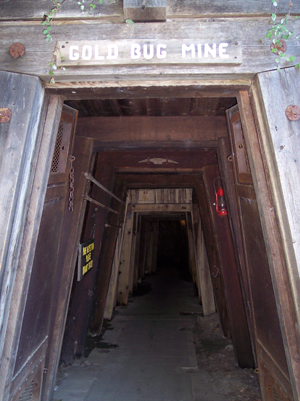 The Gold Bug Mine (originally the Hattie Mine) is a typical hard rock mine found in the Mother Lode. If you haven’t had the opportunity to safely explore an underground mine, or want to introduce your kids to a little fun and history, Gold Bug Park is ideal. Not only can you can go underground, but you can visit a stamp mill and blacksmith shop, have a picnic, and do a little hiking, too. When you buy your tour ticket, you’ll get a hard hat to wear and a hand-held audio wand. As you make your way through the mine, the voice of an old-timer tells the tales of the Gold Bug and the California Gold Rush. Article continued here... Monday, December 10 2012
The Gold Prospectors Association of America (GPAA) has announced its 2013 Gold & Treasure Expo schedule. Coast to coast, there are 13 shows, including some new locations, and all are set to be bigger and better than ever. GPAA is using the word "Expo" now to emphasize that the shows feature not only educational classes, but vendors ready to sell you products and answer your questions. Monday, November 05 2012
Drywashers are like highbankers, but they do not use water, making them excellent tools for recovering gold from dry material in desert areas. A dry washer is basically designed to be a waterless sluice. It separates gold from sand and other waste material with pulsations of air, vibrations, and static electricity instead of running water. 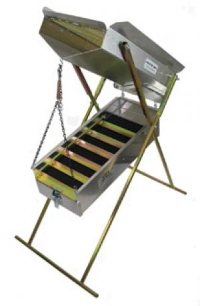 The top portion of a drywasher is called a hopper and consists of a box covered with wire screen. The screen is called a "grizzly." Dry gold-bearing material is fed onto the grizzly, which is mounted at a fairly steep angle. Thinner material, such as dirt and small gravel, falls through the grizzly screen and into the hopper. Larger material, such as rocks and sticks, roll off the grizzly and back onto the ground. Material from the hopper is then fed by gravity into the riffle tray below (looks like a sluice box), through an opening in the bottom of the hopper. Wednesday, October 03 2012
Garrett has announced that the AT Gold introductory detector package that includes the detector, headphones, gold pan, book, vials and other FREEBIES, will no longer ship with the FREE stuff. Instead, buyers will get the detector and headphones only for the same price. You can still get the package with FREEBIES for a limited time, so order your AT Gold detector package now while still available!
Garrett is also phasing out the GTI 1500 and the GTP 1350 detectors at the end of 2012. If you are considering one of these machines, buy now while still available. Reminder — GoldRushTradinPost.com offers FREE SHIPPING on all detectors $350 or more! Sunday, September 02 2012
If you're looking for metal detector that will find the smallest gold nuggets in highly mineralized soils, then Fisher's Gold Bug Pro is your machine! Fisher's legendary Gold Bug now incorporates new state-of-the-art advanced algorithms to provide you with extreme ground/target information. It's a multi-purpose detector, and a new coil combo package makes the popular Gold Bug Pro detector even better! This special package at a special price pairs the Gold Bug Pro with the 5” DD coil AND the 10" DD elliptical coils.
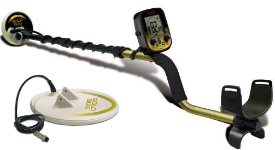 This is the perfect detector and coil combination for prospectors and relic hunters at a special low price. The recently new 5x10 solid DD coil has excellent depth and unbelievable target separation capabilities and has become the go-to coil for many. This coil was designed for the Gold Bug series and it has incredible sensitivity to small targets. It's a real must-have for gold prospectors, and the solid construction makes it great for field stubble. Excellent for coins, relics and jewelry hunting and the standard 6.5 foot cord has shallow water hunters cleaning up. Here's what you can expect from the Gold Bug Pro Metal Detector Coil Combo:
Sunday, August 19 2012
Lightweight and designed for outdoor adventurers and anyone who likes to be prepared, Aurora Fire Starters will start a lifetime of campfires and are considered the best all-around survival fire starter in the world! Two models are now available and are perfect for prospectors who also camp while in the field. The 440C model is equipped with a stainless steel striking blade made from fully hardened 440C stainless steel that can be flipped over to reveal a fresh striking surface or be sharpened after prolonged use.
The 2SA model is equipped with a tungsten carbide (super alloy) striking blade that will never dull and will give even better sparks because it is one of the hardest materials on earth. The super alloy striking blade can also be used to sharpen knives in the field. The super alloy blade was designed for military personnel and is the best fire starter out there— as validated by the Navy Diver Olympics and the 2SA has even been up Mt. Everest! Monday, August 06 2012
Do you have a website, blog, or forum that caters to gold prospectors, metal detectorists, treasure hunters, or rockhounds located in the USA? Would you like the opportunity to earn an 8% commission on all sales you refer to our website? If so, we invite you to join the Gold Rush Trad ing Post Affiliate Program!
How It Works We use a trusted third party affiliate solutions provider (Shareasale.com) to track referred sales, calculate commissions on those sales, and send out commission checks. Once you complete your affiliate application with Shareasale.com and are approved (it's free to sign up), you will be provided with a unique ID and tracking links that tell our system whenever you refer a visitor. If that visitor decides to make a purchase within 60 days of clicking your link, you earn 8% of the purchase price (excluding shipping). Tracking, reporting and payments are handled by Shareasale, and your affiliate account will include up-to-date earnings reports and stats. Program Details
Friday, July 13 2012
It's summer, and that probably means you'll be vacationing or playing near water this month. Whether you're heading to a local lake or to an ocean across the country, take your metal detector. Beach hunting is fun and easy, and usually the finds are, well, pretty fine! Recovering an object from sand is pretty easy, too, especially compared to digging in hard ground. A sand scoop makes target recovery fast and easy.
Water and sunscreen have a sneaky way of slipping rings from fingers of swimmers and sunbathers, making beaches a lucrative location for metal detecting. Necklaces, watches, and bracelets are also great finds on beaches, along with coins— lots of coins. Although some beaches can yield historic artifacts, most finds will likely be of the modern variety. Some detectorists will argue that the best time to find goodies on a beach is after winter storms. While that’s certainly true, summer crowds can mean a fresh crop of coinage and jewelry just waiting to be found by you. Beach hunting can be done in dry sand or out in the water where many more rings are lost. Salt water beaches present special problems (mineralization) and you must determine if you will hunt only in dry sand, dip the coil under water in the shallows, or desire a totally submersible metal detector suitable for deep water wading or diving. All quality metal detectors have submersible search coils but not all control boxes are waterproof or suitable for the pressures of deep water diving, so match your detector to the type of detecting you’ll do. In all types of beach hunting, the discrimination must be kept very low, eliminating only small iron (bobby pins and nails). Aluminum pull tabs and tin foil should not be discriminated or gold and/or platinum rings may not be detected. Some beach hunters operate with zero discrimination and dig everything. Article continued here... Sunday, June 24 2012
The words "concentric" and "DD" (or "double-D") refer to the type of your metal detector's internal coil construction. Most searchcoils (whether round or elliptical) are of concentric construction. A concentric searchcoil has a large transmitter coil, and a smaller receiver coil in the center, usually in the same plane. This coil arrangement is relatively easy to manufacture and its symmetry helps to minimize electrical drift due to time and temperature. It also provides good discrimination on shallow targets.
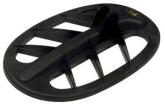 Some searchcoils (whether round or elliptical) are of DD construction. Double-D's comprise two overlapping D-shaped coils of approximately the same size, one being the transmitter and the other the receiver. The advantages of the DD are greater depth in mineralized soil, a broad sweep pattern, and narrower target response. Its primary disadvantages from a user's point of view are multiple responses on shallow targets and poor discrimination of flat iron objects. Designing and manufacturing them is more difficult because their lack of radial symmetry makes them prone to drift which the design and the manufacturing process must minimize. Manufacturing cost is higher because the coils cannot be wound on high-speed winding equipment. Some searchcoils (whether round or elliptical) are of DD construction. Double-D's comprise two overlapping D-shaped coils of approximately the same size, one being the transmitter and the other the receiver. The advantages of the DD are greater depth in mineralized soil, a broad sweep pattern, and narrower target response. Its primary disadvantages from a user's point of view are multiple responses on shallow targets and poor discrimination of flat iron objects. Designing and manufacturing them is more difficult because their lack of radial symmetry makes them prone to drift which the design and the manufacturing process must minimize. Manufacturing cost is higher because the coils cannot be wound on high-speed winding equipment.Double-D's are usually preferred for relic hunting and gold prospecting. Concentrics are usually preferred when searching for modern coins in an area where there is also iron and aluminum trash. Read more about searchcoils here... Friday, June 01 2012
A highbanker is basically a sluice box with mobility and added height. It is mounted on a 4-legged stand that gives the sluice box the correct slope. Instead of being put right in the creek like a sluice, an engine with a water pump and some hoses transports the water up from the stream into the highbanker. Highbankers are also called power sluices. It is a self-contained unit with many uses— prospecting, sampling, and concentrate clean up.
In general, a highbanker or power sluice is  extremely efficient at trapping gold, including very fine or "flour" gold. The biggest benefit of having this piece of gold prospecting equipment is the ability to process gold-bearing gravels located a distance away from a water source— in other words, you get to bring the water to the gravel, not the gravel to the water! You can purchase a highbanker with a pump/motor and all hoses and fittings included, or you can buy those items separately. extremely efficient at trapping gold, including very fine or "flour" gold. The biggest benefit of having this piece of gold prospecting equipment is the ability to process gold-bearing gravels located a distance away from a water source— in other words, you get to bring the water to the gravel, not the gravel to the water! You can purchase a highbanker with a pump/motor and all hoses and fittings included, or you can buy those items separately.To run a highbanker, you need a system to pump water to it. Highbanker pumps can be either electric (12 volt battery) or gas driven. Some highbankers are also designed and constructed to re-circulate water so they can be employed in situations where little water is available. Keep in mind that the pumps deliver less water as your equipment location is moved uphill. Pumping uphill increases the resistance on the pump, and as you move uphill, eventually there is a point where the pump will not provide sufficient water to run the high banker. The slope on the highbanker usually ranges from about three to four inches per foot. Article continued here... |
|
Nugget of News Blog |






